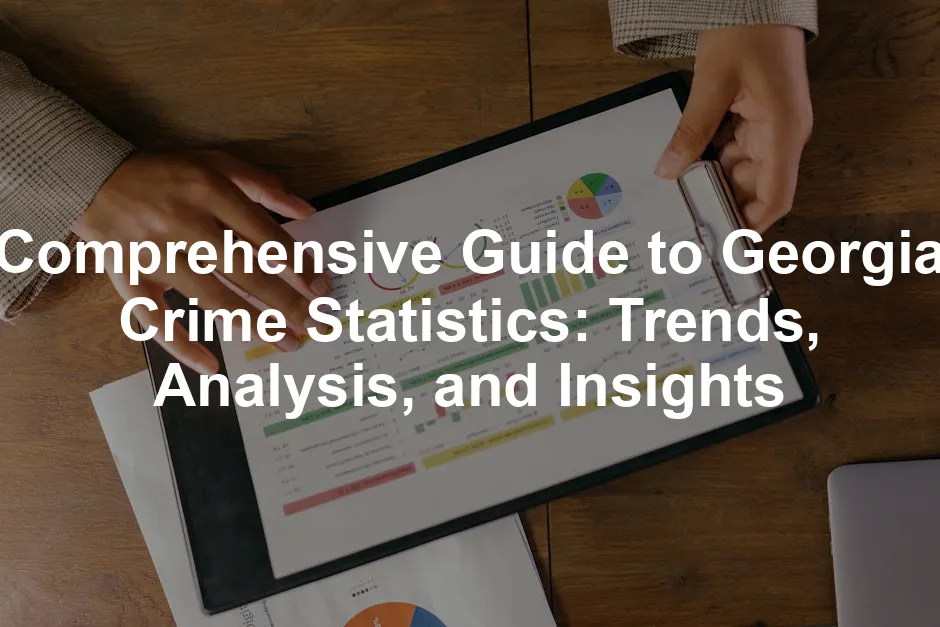Introduction
Understanding crime statistics in Georgia is vital for everyone. These numbers help residents stay informed and equip policymakers with the data they need to make decisions. Crime statistics represent the frequency of various offenses, thus painting a picture of safety in communities. Crime statistics are collected through the Uniform Crime Reporting (UCR) Program. The UCR is a nationwide effort managed by the Federal Bureau of Investigation (FBI). It requires law enforcement agencies to report data on serious crimes, like murder or robbery. This data is crucial for assessing crime trends over time. In Georgia, the Georgia Bureau of Investigation (GBI) plays a significant role in gathering and disseminating this information. The GBI collects crime data from local law enforcement agencies throughout the state. This ensures that the statistics reflect the actual situation on the ground. If you’re looking to dive deeper into the psyche of crime and its implications, check out Crime and Punishment by Fyodor Dostoevsky. Dostoevsky’s exploration of morality and guilt is a gripping read that might just make you rethink the motives behind crime. The significance of crime statistics extends beyond mere numbers. For residents, these statistics provide insight into their safety and the environment in which they live. Policymakers rely on this data to create effective crime prevention strategies and allocate resources efficiently. Law enforcement agencies use crime stats to identify patterns and target specific areas needing attention. As we navigate through Georgia crime statistics, we will discuss various data sources, trends, and insights. This comprehensive overview will help you understand how this information affects communities across the state. By staying informed, residents can contribute to a safer environment for themselves and their neighbors.For a deeper understanding of crime statistics in Georgia, check out this detailed analysis: Georgia crime statistics.

Georgia Crime Overview
Understanding Crime Statistics
Crime statistics serve as a barometer of public safety. They quantify the number of crimes committed within a specific timeframe, providing valuable insights into trends. The purpose of these statistics is to inform citizens, law enforcement, and policymakers about crime dynamics in their areas. The Georgia Bureau of Investigation (GBI) and the FBI’s UCR Program are the primary sources of crime data in Georgia. The GBI compiles data from over 600 law enforcement agencies across the state, ensuring comprehensive coverage. The FBI’s UCR Program standardizes the reporting of crime data nationwide, allowing for effective comparisons.Current Crime Rates
As of the latest reports, Georgia has recorded a total of 224,561 crimes. This figure includes 40,048 violent crimes and 184,513 property crimes. To break it down further, the crime rate per 1,000 residents stands at 20.58 for total crimes. Specifically, the violent crime rate is 3.67, while property crime rates are significantly higher at 16.91 per 1,000 residents. When compared to national averages, Georgia’s crime rates reveal interesting insights. The national median for violent crime is 4 per 1,000 residents, indicating that Georgia is slightly below that figure. In contrast, the property crime rate in Georgia is lower than the national median of 20 per 1,000 residents. This suggests that while violent crime remains a concern, property crime is relatively well-managed in the state. Understanding these statistics is crucial for residents. They help evaluate the safety of neighborhoods and inform personal safety decisions. Additionally, the data serves as a foundation for community discussions on crime prevention and resource allocation. By engaging with these statistics, residents can actively participate in efforts to enhance safety in their communities. For those intrigued by the psychology of crime, I highly recommend Mindhunter: Inside the FBI’s Elite Serial Crime Unit by John E. Douglas. This gripping read offers insights into the minds of some of the most notorious criminals and the dedicated agents who track them down.
Breakdown of Crime Types in Georgia
Violent Crime Statistics
Overview of Violent Crimes Violent crimes are serious offenses. They include murder, rape, robbery, and aggravated assault. Each crime tells a story about community safety. The impact of these crimes can be devastating. Understanding their prevalence is essential. Latest Violent Crime Data Recent statistics reveal concerning figures. In Georgia, 40,048 violent crimes occurred last year. This equates to a rate of 3.67 per 1,000 residents. To break it down further, here’s what the numbers look like:| Crime Type | Number of Crimes | Rate per 1,000 Residents |
|---|---|---|
| Murder | 893 | 0.08 |
| Rape | 3,977 | 0.36 |
| Robbery | 4,753 | 0.44 |
| Assault | 30,425 | 2.79 |
Property Crime Statistics
Definition and Examples Property crimes are more common than their violent counterparts. They include theft, burglary, motor vehicle theft, and vandalism. While these offenses might seem less severe, they still impact community safety significantly. Latest Property Crime Data The property crime statistics in Georgia are striking. Last year, property crimes totaled 184,513. This translates to a rate of 16.91 per 1,000 residents, showcasing a significant issue. Here’s a breakdown of the data:| Crime Type | Number of Crimes | Rate per 1,000 Residents |
|---|---|---|
| Burglary | 23,772 | 2.18 |
| Theft | 138,207 | 12.66 |
| Motor Vehicle Theft | 22,534 | 2.06 |

Crime Hotspots
Geographic Trends
Georgia’s crime landscape reveals notable geographic trends. Certain neighborhoods in urban areas witness a spike in crime rates. Cities like Atlanta and Savannah experience higher incidents of violent crimes compared to rural counterparts. This discrepancy often relates to economic factors. In areas with higher poverty rates, crime tends to rise. A bustling city may attract more people, and with it, an increase in opportunity for crime. Factors like population density and limited employment options can foster environments where crime flourishes. Additionally, the influx of residents in urban settings can strain resources. Overburdened law enforcement may struggle to maintain public safety effectively. The correlation between economic downturns and rising crime rates is evident. For instance, when job opportunities dwindle, desperation can lead to increased criminal behavior. Understanding these geographic trends is crucial for targeted crime prevention efforts and community safety enhancement.Impact of Urban vs. Rural Areas
Urban areas in Georgia face distinct challenges compared to rural regions. Urban centers often report a higher rate of violent crimes, including assaults and robberies. In contrast, property crimes, such as burglary and larceny, can be more prevalent in rural settings. This difference can often be attributed to varying population densities. Urban areas, bustling with activity, provide more targets for thieves, while rural areas may experience higher property crime rates due to isolation. Moreover, resource allocation plays a pivotal role. Urban police departments often have more resources and support systems in place. They can implement community policing initiatives, fostering relationships between law enforcement and residents. Conversely, rural areas may lack such resources, making it challenging to combat crime effectively. Understanding these disparities helps communities strategize and adapt their crime prevention measures efficiently. By analyzing geographic trends and the urban-rural divide, we can better comprehend the complexities of crime in Georgia. This understanding empowers communities to address their unique challenges and enhance public safety.
Conclusion
Understanding GA crime statistics isn’t just about numbers. It’s about community safety, awareness, and engagement. This guide has unveiled some eye-opening findings regarding crime trends in Georgia. With a total of 224,561 crimes reported, including 40,048 violent crimes, these statistics provide a snapshot of our safety landscape. It’s clear that while violent crime rates are slightly lower than the national average, property crimes remain a significant concern. Staying informed about crime statistics is crucial. Knowledge empowers individuals to make informed decisions about their safety and community involvement. By understanding where crime occurs, residents can take proactive measures to protect themselves and their neighborhoods. Whether it’s participating in community watch programs or advocating for better resources for law enforcement, every action counts. Moreover, communities thrive when residents engage with local crime prevention initiatives. Support from the public can enhance the effectiveness of these programs. So, if you hear about a local crime prevention meeting or initiative, don’t hesitate to participate. Your input can lead to safer streets and a more connected community. For those looking to dig deeper into crime statistics, several resources are available. Websites like the Georgia Bureau of Investigation offer comprehensive data and reports. They provide insights that can aid in understanding specific localities and the nuances of crime trends. If you’re looking for a gripping read that dives into crime and its consequences, consider The New Jim Crow: Mass Incarceration in the Age of Colorblindness by Michelle Alexander. It addresses systemic issues in the criminal justice system, making it a thought-provoking read. In conclusion, being informed about crime statistics in Georgia offers more than just data. It fosters a culture of awareness and responsibility. By staying vigilant and engaged, we can contribute to a safer environment for ourselves and future generations. Let’s make that commitment together!FAQs
What are the most common crimes in Georgia?
The most prevalent crimes in Georgia include theft, burglary, and assault. Larceny alone accounts for a significant portion of reported incidents.
How is crime data collected and reported?
Crime data in Georgia is collected via the Uniform Crime Reporting (UCR) Program. Local law enforcement agencies submit monthly reports detailing offenses, ensuring a comprehensive overview of crime trends.
What should residents do if they feel unsafe?
If residents feel unsafe, they should trust their instincts. Seek help immediately, whether it’s talking to a neighbor, contacting local law enforcement, or utilizing emergency services.
How can community members help reduce crime?
Community members can play a vital role in reducing crime through active participation in neighborhood watch programs, attending community meetings, and fostering communication with local law enforcement.
Where can I find more detailed crime statistics for my area?
For detailed crime statistics, residents can visit the Georgia Bureau of Investigation’s website or local police department resources. These platforms provide comprehensive data and insights tailored to specific areas.
All images from Pexels




